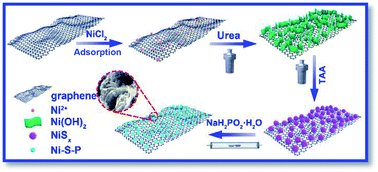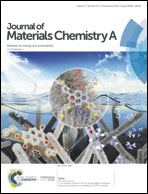Anionic P-substitution toward ternary Ni–S–P nanoparticles immobilized graphene with ultrahigh rate and long cycle life for hybrid supercapacitors†
Abstract
Designing and exploring earth-abundant but high-performance electrode materials are of crucial significance for the future large-scale development of supercapacitors. Herein, a facile anionic P-substitution strategy is used to in situ decorate ternary Ni–S–P nanoparticles on graphene nanosheets (G/Ni–S–P) for supercapacitors for the first time. Benefitting from the unique hierarchical structure and positive synergistic effects between each component, the resultant G/Ni–S–P composite delivers a spectacular specific capacity of 1406 C g−1 at 1 A g−1 with an outstanding rate capability of 60.2% at 120 A g−1, which is highly superior to those of the previously reported nickel based composites. The asymmetric supercapacitor assembled with the G/Ni–S–P and graphene/FeOOH composite as the cathode and anode exhibits high energy density up to 58.1 W h kg−1 and superb electrochemical stability with 4.9% decay after 30 000 continuous charge/discharge cycles. These intriguing electrochemical performances indicate that the G/Ni–S–P composite has enormous potential application in high-performance energy storage systems in the future.



 Please wait while we load your content...
Please wait while we load your content...